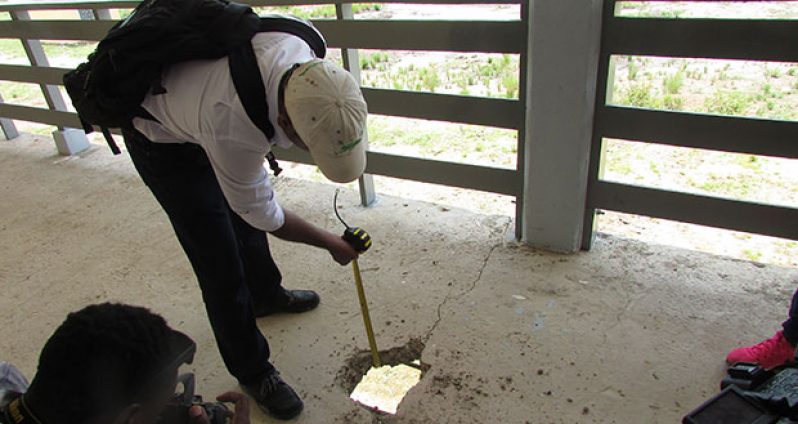REMEDIAL works to the Kato Secondary School in Region Eight could cost more than $140M, according to representatives of the auditing company, Rodrigues Architects Limited. Kares Enginneering was contracted to build the school at a cost of $728 million, but according to the Ministry of Public Infrastructure, it is estimated that 60 per cent of the school has defects.
“To the naked eye, you can tell that something is wrong. You don’t need any level of expertise to see that,” said Davendra Doodnauth, an architect attached to Rodrigues Architecets, as he pointed to a huge hole along one of the corridors during a visit to the school Wednesday.

The auditing firm, along with representatives from the Ministries of Public Infrastructure and Education, was on a site visit.
According to Managing-Director of Rodrigues Architects Ltd., Albert Rodrigues, the school has “countless” structural defects. These flaws were highlighted in both the draft and final report of the project submitted to the Ministry of Public Infrastructure by the company.
In the report, a number of issues were highlighted, ranging from the prioritising of cost effectiveness over professional competence to the use of inadequately qualified consultants for the project.
Additionally, countless flaws on the physical structure of the school were pointed out by architect Davendra Doodnauth of Rodrigues Architects. Amongst the areas highlighted were bad timbers, exposed electrical outlets, cracking stairways and exposed steel.
“How could any self-respecting contractor accept work like this?” Rodrigues questioned, while pointing to another defect.
Both Doodnauth and Rodrigues further said that the project was flawed from its design phase, a fact that was evident in the incorrect orientation of the facility.
According to Doodnauth, the classrooms were incorrectly placed away from the windward side and would ultimately lead to hot, uncomfortable classrooms. Additionally, it was highlighted that the dining room and kitchen could not accommodate the school’s projected number of students. Safety concerns were also noted since the school lacked fencing. This was especially concerning due to the fact that the school would be housing at least 250 students in its dormitories.

These issues were brought to the attention of the contractor and consultants for the project; however, their responses were lacking.
During the visit, residents of the village complained bitterly about the situation. According to them, during the conceptualization stage of the project, it was agreed that local workers and local mateials would have been utilized, but the contractor reneged on the agreement at the commencement of the project.
While the community was initially hired to cut the timber at the start of the project at $80 BM, this contract was taken away from them and given to someone else at the rate of $30 BM.
Additionally, the initial wage of $7,000 per day that was promised to workers was never paid. Rather, workers were paid $2,500 per day, $1,200 of which was deducted each day for meals.
The Village’s Toshao said residents were anxious for the school’s opening but soon became disappointed upon learning of all the defects. He said that the situation at the Paramakatoi Secondary School has become untenable due to overcrowding. As a result, students are forced to attend schools as far away as Sand Creek, Region Nine, due to the lack of available facilities.
“The current situation has certainly put a strain on us. Right now, everyone is just waiting to see what happens, from the teachers to the parents to the students,” he said.



.jpg)









